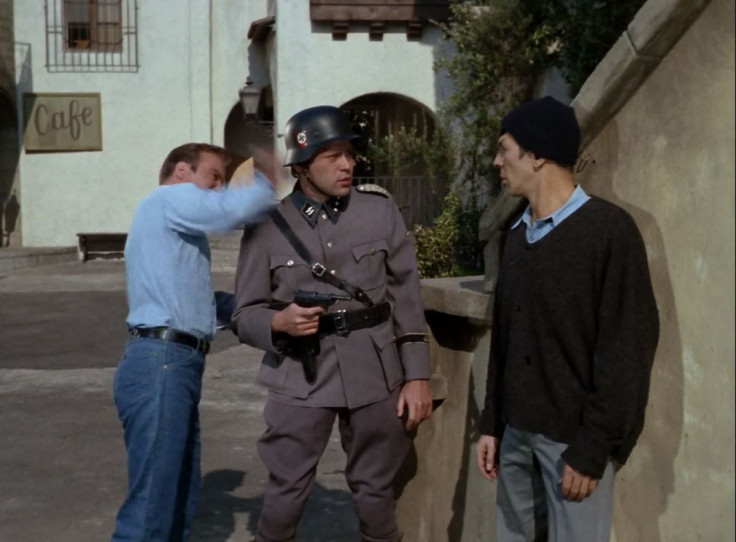Rather than a parable or loosely-cloaked analogy, the Star Trek Season 2 episode “Patterns of Force” pits the United Federation of Planets against 20th century Nazis, complete with sieg heil salutes and militant rallies. On approach to the two-planet system Ekos and Zeon (pronounced close to ‘Zion’), the USS Enterprise is very nearly blown up by a thermonuclear rocket. After beaming down to investigate, Captain James T. Kirk and his first officer Spock first encounter a frenzied man, yelling to them, “Hide! They’re right behind me! Hide!” ‘They’ are Ekosian Nazis with swastika armbands, out on patrol against the “Zeon pigs.” Fascism is an unsubtle ideology, so Star Trek doesn’t play it subtle.
Neither does Donald Trump, who drew an equivalence during a Tuesday press conference at Trump Tower between neo-Nazi, white supremacist, militia, neo-Confederate and white nationalist factions protesting the removal of a Robert E. Lee statue with counter-protesters. “What about the alt-left that came charging at, as you say, at the alt-right?” Trump asked reporters. “You also had some very fine people on both sides.”
In parroting Fox News talking points Trump brought a narrow debate about protest tactics and the morality of violence to a crisis point. By legitimizing the racist and fascist right-wing who have organized around him, Trump has provided a tacit state endorsement for further violence, making the question of whether punching Nazis and antifa (anti-fascist) violence is justified — a point of contention between centrists and leftists — more pertinent than ever.
Star Trek picks a clear side in “Patterns of Force,” not only wholly rejecting fascism as a governing ideology and endorsing extreme tactics in its defeat, but also exploring how fascist movements pull in followers.

Kirk and Spock knock multiple Nazis unconscious as they work their way toward the fuhrer — John Gill, a disgraced Starfleet historian who brought Nazi ideology to the Ekos in the hopes it would help a backward society develop quickly (based in the erroneous premise that fascism is economically efficient). But violence isn’t their first choice — they are clever and work in concert with existing freedom fighter groups. Still, “The Patterns of Force” never shies away from the violence and authoritarianism inherent in fascism or equivocate on the merits of a violent response. Antifa has a friend in Star Trek.
But don’t take “Patterns of Force” screenwriter John Meredyth Lucas’ word for it. Just associating Star Trek’s good values with its Nazi-punching values doesn’t prove much, except to the extent that Star Trek’s values are a useful proxy for liberal values, particularly of a variety mild enough for nationwide TV. By that standard, “Patterns of Force” suggests violence against anyone wearing a swastika armband or professing fascist values is very near to national common wisdom and utterly unremarkable.
Still, Star Trek is TV and TV stories are often dependent on violence, leaving up to debate whether Star Trek’s violence against Nazis is just unthinking narrative convention or endorsement. So while we can look to pop culture for the endorsement of values, rarely does pop culture provide supporting evidence and an argument beyond the pat moral lesson delivered at episode’s end. We’ll have to look elsewhere for support of Star Trek’s Nazi Punching policy. Those sympathetic to antifa violence offer rationales that embrace, knowingly or not, Karl Popper’s paradox of tolerance, which preserves a society’s right “not to tolerate the intolerant” otherwise the intolerant inevitably end up in control. Unsurprisingly, it was fascism Popper had in mind.
It’s this expansive justification for antifa that seems most clearly aligned with Star Trek’s values, which deploys violence against fascism both protectively and ideologically. In the episode “Errand of Mercy,” Kirk and Spock preemptively attack and undermine a Klingon occupation in anticipation of the violence to come. Still, both “Errand of Mercy” and “Patterns of Force” warn against a love of violence and the temptations of its pursuit.
“You should make a very convincing Nazi,” Spock tells Kirk before they don disguises. Even among humans more peaceful, charitable and beautiful than any in our history, Spock still sees our species as closer to Nazis than Vulcans, prone to adopt components and values of fascism. Though it doesn’t always live up to its self-professed values, Star Trek can always be relied upon to anticipate and expect great things from the human race. There’s a lot of room grow and be better as a species, Star Trek insists. But there is no room in the future for fascism.



















